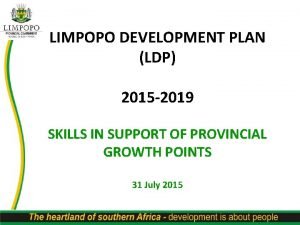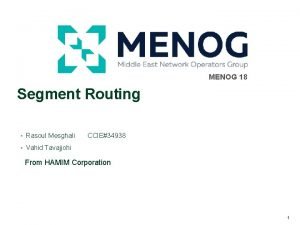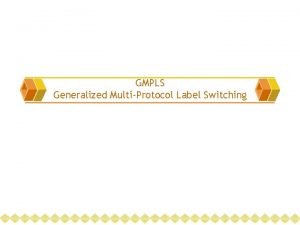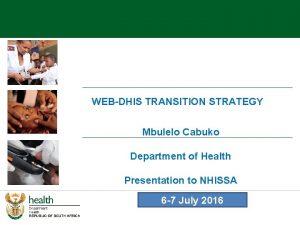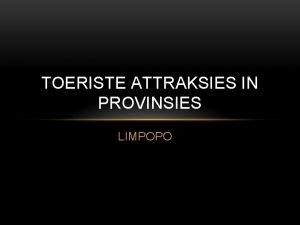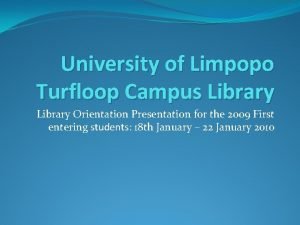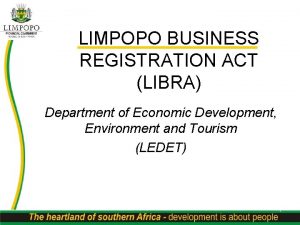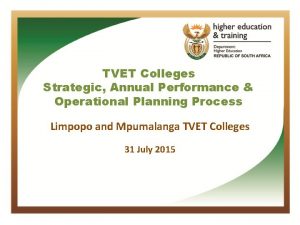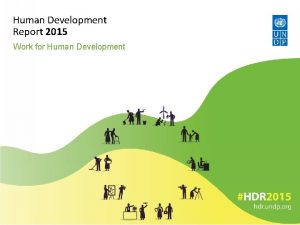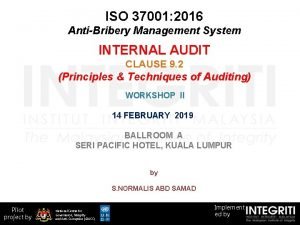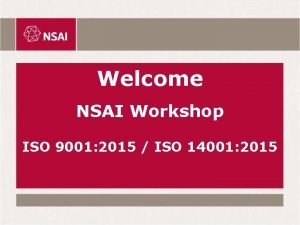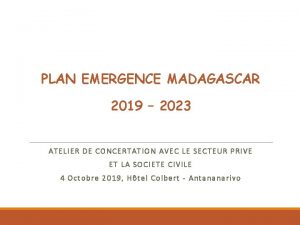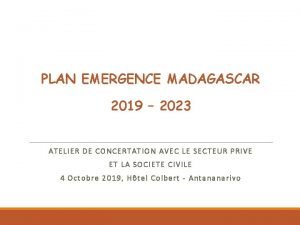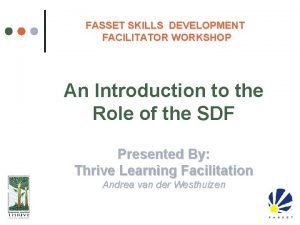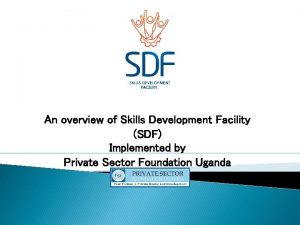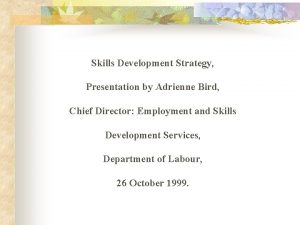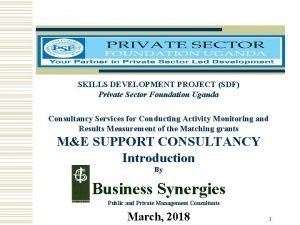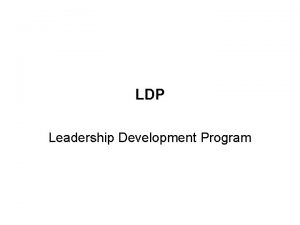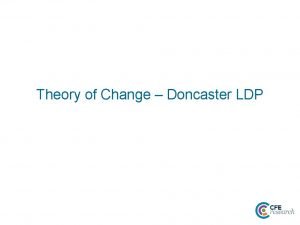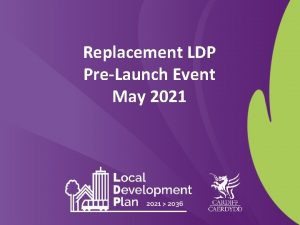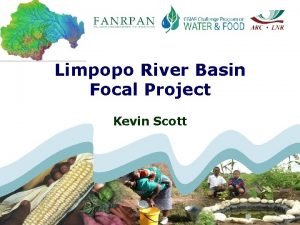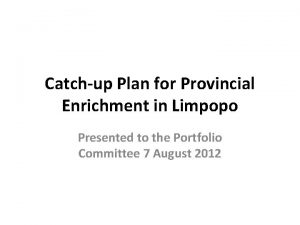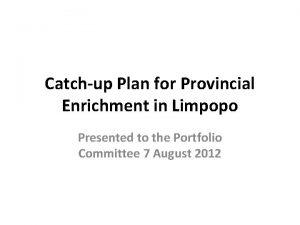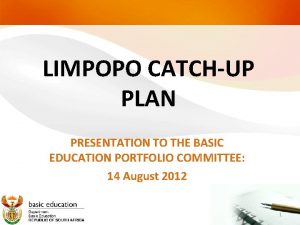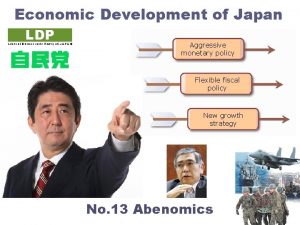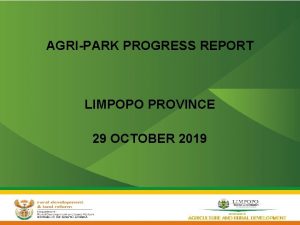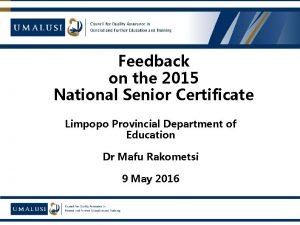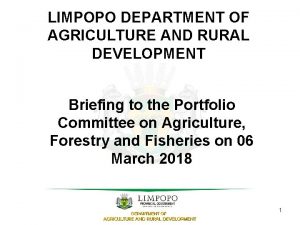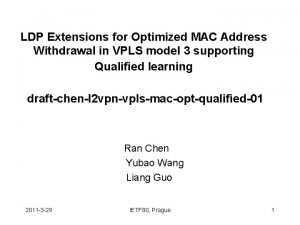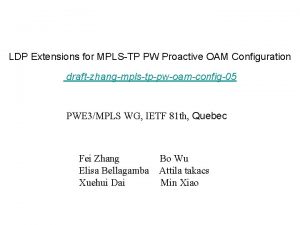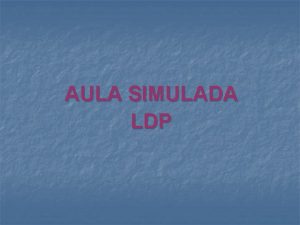LIMPOPO DEVELOPMENT PLAN LDP 2015 2019 SKILLS IN





























- Slides: 29

LIMPOPO DEVELOPMENT PLAN (LDP) 2015 -2019 SKILLS IN SUPPORT OF PROVINCIAL GROWTH POINTS 31 July 2015

PRESENTATION OUTLINE 1. 2. 3. 4. 5. 6. 7. 8. 9. 10. 11. 12. INTRODUCTION & PURPOSE PROVINCIAL VISION & OBJECTIVES PROVINCIAL TARGETS MAXIMISING CONTRIBUTION TO ECONOMIC GROWTH THROUGH PROVINCIAL GROWTH POINTS GROWTH POINT DEVELOPMENT IN SUPPORTING INDUSTRIAL CLUSTER DEVELOPMENT PROGRAMMES AND ANCHOR PROJECTS IN SUPPORT OF GROWTH POINTS ENSURING SUSTAINABLE GROWTH POINTS INFRASTRUCTURE PRIORITIES IN SUPPORT OF GROWTH POINTS POLICY LEVERS OF THE IUDF (Draft) GROWTH POINT SUSTAINABILITY STRENGTHENING INSTITUTIONAL ARRANGEMENTS CONCLUSION

1. INTRODUCTION & PURPOSE • Aim of the Limpopo Development Plan… – Is to inform planning and resource allocation at both provincial and municipal levels, and also to provide a strategic partnership between government, private sector & civil society. • The LDP focusses on the five-year period from 2015 – 2019.

1. INTRODUCTION & PURPOSE In support of the NDP Chapters and MTSFs 14 Developmental Outcomes, the LDP strives for economic development and transformation to enable the province to address the triple challenges of poverty, inequality and unemployment, as well as improving Service Delivery

Linkage between the NDP Chapters & MTSF Outcomes – NDP Chapters MTSF Outcomes 9. Improving education, training and innovation 5. Skilled and capable workforce to support and inclusive growth path

Outcome 5 (Skilled and Capable Workforce) ROLES FOR LIMPOPO DEPARTMENT OF EDUCATION AND OFFICE OF THE PREMIER: the following sub-outcomes have been identified to improve performance: 1. 2. 3. 4. 5. 6. 7. 8. 9. An expanded, effective, coherent, integrated and quality post-school system Strengthened governance and management of institutions Improved equity in access and quality of outcomes. Transparency and quality of information strengthened vocational and continuing education and training Integrated work-based learning within the TVET system Improved performance of skills development system A new generation of high quality lecturers Expanded production of highly skilled professionals and enhanced innovation 6

2. PROVINCIAL VISION The vision of the province , as outlined in the LDP, remains to fulfil the potential for prosperity in a socially cohesive, sustainable and peaceful manner 7

2. DEVELOPMENT OBJECTIVES OF THE LDP (Noting the emphasis on issues of Sustainability) Create decent employment through inclusive economic growth and sustainable livelihoods Improve the quality of life of citizens Ensure sustainable development OBJECTIVES Raise the effectiveness and efficiency of a developmental public service Prioritise social protection and social investment Promote vibrant and equitable sustainable rural communities 8

3. PROVINCIAL TARGETS by 2019/20 F/Y The following targets are set to ensure attainment of the provincial goals: • Limpopo’s Growth Trajectory Scenario (Current MTSF) • • at 3% (LEDET) Increase Matric pass rate from 72. 9% in 2014 to beyond 80% (LDE) Create 429 000 jobs (LEDET) Reduction of official unemployment rate from 16. 9% in 2014 to 14%. (Expanded unemployment rate from 38. 4% in 2014 to less than 33%) (LEDET) Access to basic services (water) from 83% in 2014 to 90% (Co. GHSTA) 9

PROVINCIAL TARGETS by 2019/20 F/Y The following targets are set to ensure attainment of the provincial goals: • Electricity supply from 83% in 2014 to 90% (Co. GHSTA) • Sanitation from 43% in 2014 to 50% (Co. GHSTA) • Reduce HIV Incidence from approx. 9% of the total population • • • of Limpopo in 2014 to 5% (LDH) Life expectancy M = 58. 3, F = 62. 5 in 2014 to M = 60, F = 65 (Co. GHSTA) Inequality (Gini-Coefficient) from 0. 61 to 0. 50 (LEDET) GGP contribution to GDP – increase the provincial contribution to national GGP from the current 7. 1% (LEDET) 10

3. MAXIMIZE CONTRIBUTION TO ECONOMIC GROWTH THROUGH PROVINCIAL GROWTH POINTS – The LSDF classified municipalities that possess potential to grow the economy of the province, as Provincial Growth Points. 17 First Order Settlements were identified – 10 PGPMs prioritized i. e. Polokwane, Mogalakwena, Ba-Phalaborwa, Musina-Makhado Corridor, Lephalale, Greater Tubatse, Elias Motsoaledi, Greater Tzaneen, Thulamela & Thabazimbi. – These municipalities have competitive advantages in the key economic sectors prioritized by the province. – The focus on Growth Points and on harnessing their competitive advantages is key to integrated sustainable rural development & sustainable human settlements – Ensuring sustainable human settlements is an integral part of economic development and improved quality of life, impacting on the urban growth points and surrounding rural communities – LDP seeks to ensure that provincial government and its stakeholders foster integrated planning for growth and development in these areas and channel necessary resources in pursuit of realizing optimal performance of their economic sectors. 11


4. Growth Point Development in Supporting Industrial Cluster Development • The focus on the Growth Points Programme will facilitate economic and spatial agglomeration, as a means of growing economies of scale in specific areas having competitive advantage/s. • The province aims to diversify the economy through placing emphasis on manufacturing thus creating value along commodities with competitive advantage within the prioritised economic sectors, in pursuit of addressing losses in employment and promoting sustained job opportunities. (Cluster Value. Chain development). 13

Harnessing the Competitive Advantages of Districts GROWTH POTENTIAL Growth potential is identified according to competitive clusters for increased development impact and sustainability/ noting the link between Clusters Competitive advantages include: 1. PGMs/Chrome in Sekhukhune (proposed SEZ) – Tubatse & Waterberg – Mokopane (LIMMBI) 2. Energy / Coal / Petrochemical in Waterberg – Lephalale (Industrial Park) and Vhembe – Musina-Makhado Corridor 3. Metallurgical in Musina-Makhado Corridor - Vhembe 4. Horticulture in Mopani and Vhembe (Agro-processing) 5. Logistics in Polokwane & Musina (proposed SEZ) 6. Red and white meat in all Districts 7. Tourism nodes and clusters in all Districts 8. Forestry in Mopani and Vhembe (Logistics, R&D, ICT & Knowledge-enabled economy etc. cut across Clusters) 14

INDUSTRIAL CLUSTER & VALUE-CHAIN DEVELOPMENT Across all Districts Polokwane Molemole Musina – Makhado Corridor Thohoyandou Tzaneen Greater Letaba Maruleng Ba-Phalaborwa Tubatse Elias Motsoaledi Ephraim Mogale Lephalale Mokopane Thabazimbi Modimolle Tourism and Meat Clusters Logistics Cluster e. g. Airport, Inter-Nodal Hub etc. Horticulture Cluster Logistics, Diamond Mining, Horticulture, Forestry, Coal and Metallurgical Clusters & SEZ Horticulture Cluster Horticulture and Forestry Cluster Copper and Magnetite Cluster Platinum and Chrome Cluster & SEZ Horticulture Cluster Coal and Energy Cluster Platinum Cluster Horticulture Cluster 15

5. PROGRAMMES & ANCHOR PROJECTS IN SUPPORT OF GROWTH POINTS & SURROUNDING RURAL Anchor Projects: COMMUNITIES Implementation of SEZs once adopted, strengthen Industrial Clusters e. g. Lephalale Coal & Petro-Chemical Cluster, Tourism Cluster across districts, Logistics Cluster, trade port and Metallurgical Cluster in Musina. Makhado Corridor, Agriculture Cluster across districts, Mineral Beneficiation, ICT and the Green Economy across Municipalities Anchor Projects: Financial Management, Strengthening the institutional capacity of government e. g. Growth Point Dev. Forums, PEGAC, Institutional Support for Infrastructure Development Anchor Projects: SMME and Co-operative development, Expanded food production on landreform farms, Agro-Processing, Manufacturing – harnessing Industrial Cluster value-chain opportunities Anchor Projects: Implementation of SIPs, Finalisation of prioritised water infrastructure schemes, roads infrastructure, Development of Strategic Infrastructure e Hubs e. g. in Polokwane and Musina, fast-track the upgrading of informal Settlements Industrialisation Programme Good Governance Programme / Institutional Efficiency Growth Points Enterprise Development Programme Infrastructure Development Programme Social Dev. Soc. Cohesion Programme Anchor Projects: Addressing Health, Social Development, Sport, Arts, Nation-Building, Safety & Security and Integrated Human Settlement Projects Skills for the Economy Programme Anchor Projects: - Development of skills for the Economy - revision and implementation of the HRD Strategy - Capacitation of Technical Service Functions in Municipalities / capacitate departments 16

Proposed Strategic Economic Zones (SEZs) Tubatse SEZ • The Tubatse SEZ is based on the availability of the PGM minerals in the area and potential opportunities through the beneficiation of PGMs. The main economic activity that will be targeted is the hydrogen fuel cell initiative of Anglo-American Platinum. Musina SEZ • The SEZ is based on two initiatives, the MUTTASHI concept and the Eco. Industrial Park. The location of Musina makes it the ideal hub to serve as the logistics port to Africa. • A complete business case for the Eco-Industrial Park has been developed. The SEZ will also be linked to the SIP 17 infrastructure project on regional integration for African cooperation and development. • Proposed Metallurgical Cluster in the Musina-Makhado Corridor • Focus on logistics, import, export and beneficiation. 17

Objectives of the SEZ policy • To promote the acquisition and development of targeted • • • industrial capabilities within the framework of the IPAP, New Growth Path and the New Development Plan, To promote beneficiation and value-addition to the country’s minerals and other natural resources, To develop world-class infrastructure required to support the development of the targeted industrial activities, To attract relevant foreign and domestic direct investment, To accelerate exports and economic growth and the creation of much needed jobs, To contribute to balanced regional development. 18

6. Ensuring Sustainable Growth Points PEOPLE A People-Centred Approach NATURAL ENVIRONMENT SOCIOECONOMIC

7. THE GREEN ECONOMY PLAN: 10 KEY FOCUS AREAS FOR IMPLEMENTATION ACROSS GROWTH POINTS • Water Management, • Sustainable production and consumption practices Sustainable Waste Management Practices • • Clean Energy and Energy Efficiency Resource Conservation and Management Agriculture, Food Production and Forestry Green buildings and the built environment Sustainable Transport and Infrastructure Green Municipalities Cross cutting matters 20

Conservation Biodiversity Areas 21

Limpopo Conservation Plan / Bio-diversity Assessment • Land-use management guidelines in protecting Critical Biodiversity Areas • The Critical Biodiversity Area (CBA) map aims to satisfy conservation targets by using the least surface area possible. The CBA map is the conservation sector’s input into final spatial planning instruments. Where alternatives are identified, the CBA map actively avoids conflict with development objectives

8. Infrastructure Priorities in support of Growth Points: SIPs q SIP 1: Unlocking the Northern Mineral Belt with Waterberg as the Catalyst (Waterberg District). Urban development in the Waterberg will be the first major post apartheid new urban centre, with an emphasis on Sustainable Urban Development – a vision to be shared across Growth Points q SIP 6: Integrated Municipal Infrastructure Project q SIP 7: Integrated Urban Space and Public Transport Programme: Coordinate planning and implementation of public transport, human settlements, economic and social infrastructure and location decisions into sustainable urban settlements connected by densified transport corridors. q SIP 8: Green Energy in support of the South African economy q SIP 11: Agri-logistics and rural infrastructure q SIP 17: Regional Integration for African cooperation and development q SIP 18: Water & Sanitation Infrastructure

8. Infrastructure Priorities in Support of Growth Points • Growth Point Infrastructure Support i. e. Lephalale, • • Musina-Makhado, Tubatse, Polokwane & Mogalakwena, including rural access roads in support of Agriculture and Tourism Clusters Implementation of Bulk Water Infrastructure Programme & Reticulation / Power Support Accelerate implementation of the Freight Rail Strategy Sustainable Human Settlements NB Water & Sanitation Programme Management & Electricity , noting current situation Development of the Limpopo Integrated Infrastructure Master Plan in support of Growth Points 24

8. Infrastructure Priorities in Support of Growth Points • Improved Roads and Transport Infrastructure • • across Limpopo - building of key roads to support proposed developmental initiatives Information and Communication Technology Determine and operationalise underutilised infrastructure in support of Growth Points Maintenance of existing infrastructure (to note focus of Infra TWG – skills in support of infrastructure development) 25

9. Strengthening Institutional Arrangements in building skills • Strengthen Institutional Arrangements in support of improved skills development: ØProvincial Skills Development Forum ØPEGAC Skills for the Economy TWG (to note cochairpersonship approach) ØGrowth Point Development Fora (Skills Task Team) ØPremier’s HRD Council 26

10. Conclusion • Understand the potential of your District / Growth Point and the province as a whole • Understand the skills needs of your district / Growth Point • Prioritise Skills Development critical in harnessing economic Opportunities • Develop an area of specialisation within your TVET – focus on being an anchor to a competitive advantage within your district

Conclusion • Build partnerships with higher and further education • Build partnerships with industry • Build partnerships in the sharing of resources towards a shared vision within and between Growth Point institutions of higher learning

Conclusion • Building leadership capacity within TVETs, critical in driving implementation of the LDP, focussing on the following: Ø The management & sharing of information e. g. GIS application, skills data base etc. Ø The building of relationships & partnerships – Integration is key to Institutional arrangements e. g. Premier’s Infrastructure Coordinating Committee (PICC), EXCO Cluster Committees, Provincial Development Planning Forum (PDPF), Growth Point Development Fora etc. Ø The need for a shared vision - Critical towards ensuring a resolute public service / Purpose - Focus
 Limpopo provincial growth and development strategy
Limpopo provincial growth and development strategy Prefix
Prefix Ldp lsp
Ldp lsp Spl kpm individu
Spl kpm individu Ldp protocol
Ldp protocol Babcock ldp cpd
Babcock ldp cpd Webdhis kzn login
Webdhis kzn login Kaart van limpopo
Kaart van limpopo University of limpopo
University of limpopo Limpopo business registration act
Limpopo business registration act Tvet colleges limpopo
Tvet colleges limpopo Human development report 2015
Human development report 2015 Brian gough
Brian gough Checklist audit iso 37001
Checklist audit iso 37001 Iso 9001:2015 communication plan example
Iso 9001:2015 communication plan example Interpersonal skills and intrapersonal skills
Interpersonal skills and intrapersonal skills Slills
Slills Skills passport
Skills passport Plan emergence madagascar 2019-2023 pdf
Plan emergence madagascar 2019-2023 pdf Plan emergence madagascar 2019-2023 pdf
Plan emergence madagascar 2019-2023 pdf Public speaking training ppt
Public speaking training ppt Fine motor skills development in early childhood
Fine motor skills development in early childhood Fasset ofo codes
Fasset ofo codes Skills development facility
Skills development facility Approach to develop social factor
Approach to develop social factor Approach to develop social factor
Approach to develop social factor Adrien bird
Adrien bird Sdf uganda
Sdf uganda Cortana skill kit
Cortana skill kit Mrc skills development fellowship
Mrc skills development fellowship
